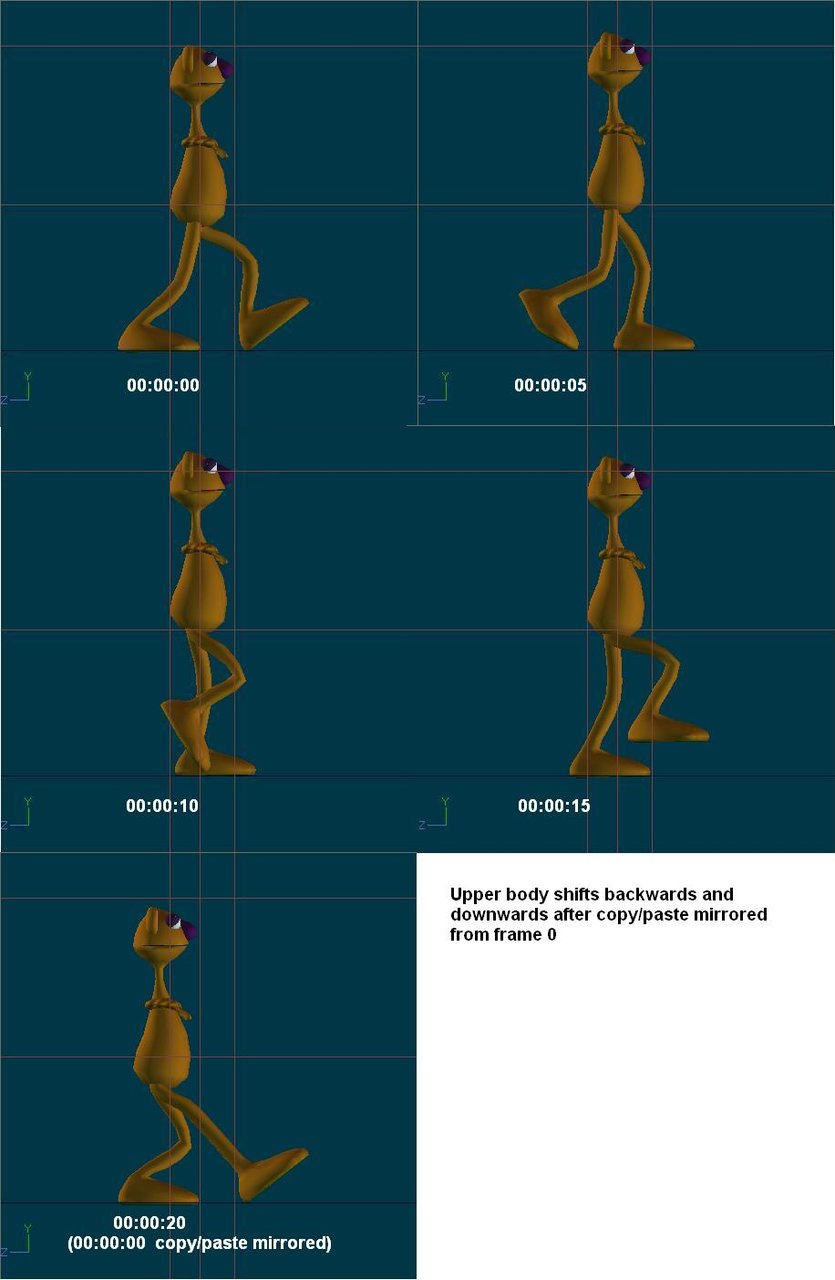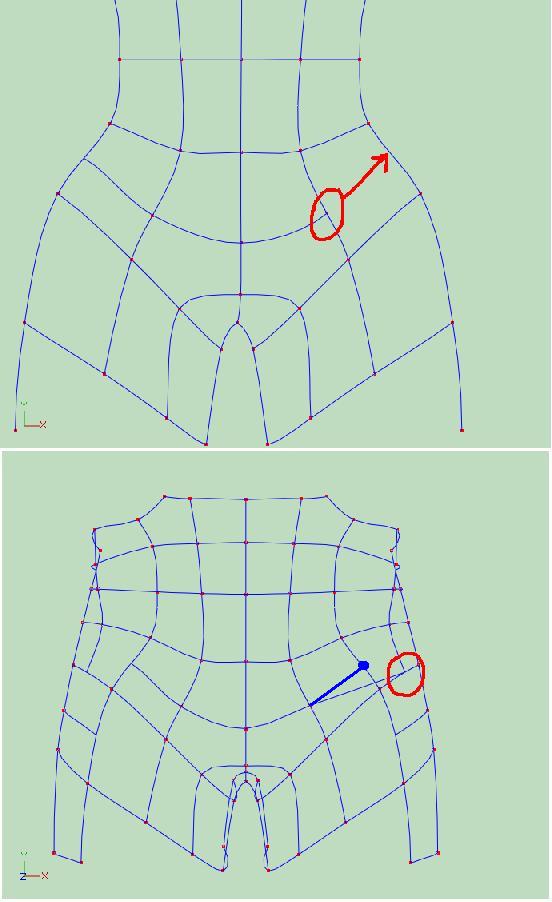
Gary
*A:M User*-
Posts
73 -
Joined
-
Last visited
Content Type
Profiles
Forums
Events
Everything posted by Gary
-
Frame 0 was keyframed. How do you tell a good keyframe from a bad one? As far as I can tell it looks ok as far as the parts of the character are where they're supposed to be in the original frame, just not on the paste mirrored one. What else do you look for?
-
Ok, I'm taking robcat's advice and I'm going to animate the walk. However.....I've run into the following problem: I've animated the keyframes for frames 0,5 10 and 15. When I try to copy/paste mirrored frame 0 to frame 20 the upper body shifts backwards and downwards (see attached pic). I've made sure to keep the body in the same horizontal position throughout, only moving it vertically. So, what am I missing?
-
So what's the best way to do that? Should I constrain Shaggy to the path first? Would I animate one complete walk cycle and then just copy and paste the keyframes from that one walk cycle over the 7 seconds? Or can I simply copy the keyframes from the existing resolute walk action and paste them repeatedly, or does that just make another action?
-
Hi all, I'm starting up yet again with exercise 6 after being away for quite a while, and I'm running into the same problem that stumped me before. I hope I can explain it properly. I want to have Shaggy walk up to the door before he tries to open it, so Ive made a path, dropped Shaggy onto it and then dropped a "resolute walk" action onto him. The walk cycle lasts for 7 seconds. When he reaches the end of the walk cycle, I want to bring him to a standing stop with his feet together and his hands at his side, but the walk cycle goes about 3 or 4 frames too far in terms of the hand and feet positions. Can I stop him before the end of the path/walk cycle and make keyframes that would allow me to manipulate Shaggy to a standing stop position? I've tried backing up a few frames, hitting the force keyframe button and then repositioning the hands and feet, moving the timeline marker ahead 3 frames and forcing another keyframe, but what happens is that the changes I make end up happening throughout all 30 frames of the walk cycle. The foot that I bring down to the ground plane and the arms that I bring to Shaggy's side end up just shuffling along throughout the walk cycle, ruining the walk action. Could some possible give me a step-by-step on how to accomplish this, because I'm just not getting it. Thanks, Gary
-
I subscribed to Zach's podcast with iTunes, but I only get the audio on playback (I've got QT v7.0.4). Am I missing something in the settings somewhere? Thanks for any help.
-
Well, I tried what you suggested by nudging the hand and foot at frame 30 to create keyframes for them, but I still have the same problem - the hand and foot no longer operate properly in the walk cycle from frame 0, but transition to the new setting gradually from frame 0 up to frame 30. It seems that anywhere I create a keyframe it then affects the previous walk cycle. I think that I need a way to isolate the walk cycle from any subsequent manipulation I do to the character, and I can't figure out how to do that. I'm sure it's something pretty simple that I'm just ignorant of and when I hear the solution I'll probably smack myself upside the head. I've been trying to find any information about transitioning from an action to manual manipulation in the Help and Technical Reference guides, but no luck. Any help would be appreciated. Gary
-
Thanks very much, I'll give that a try tonight. One other question on the same topic: since I dropped a "resolute walk" action on Shaggy at frame 0, when I get to the end of the path where I want him to come to a stop and reach out for the doorknob, do I need to jostle all the bones that were active in the walk cycle to get them to effectively come to a stop as I add more frames, or will it automatically stop the walk cycle when the end of the path is reached? Thanks again, Gary
-
Hi all, I'm starting up again with exercise 6 after being away for quite a while, and I'm running into a problem right off the bat. I want to have Shaggy walk up to the door before he tries to open it, so Ive made a path, dropped Shaggy onto it and then dropped a "resolute walk" action onto him. When he gets up close to the door, I'm hitting the "force keyframe" button at frame 30, moving his hand up to the door and placing his feet together on the ground (in skeletal mode), moving the frame counter ahead by about 3 frames and then hitting "Force Keyframe" again. What happens is that the hand and foot motions I've changed are stretched out over the entire 33 frames instead of from just frame 30 to 33. I'm not sure what I'm doing wrong or if maybe I have the wrong idea about keyframes, but I thought that the animation would be phased in between the two keyframes. Can someone point me in the right direction? Thanks, Gary
-
I would be interested in attending meetings in the L.A. area, though I don't have much experience so far. I found the few AMLA meetings I was able to attend to be very educational, enlightening and entertaining. Great bunch of people, too. Perhaps if you posted this in the main A:M List forum it would get a little more attention. I can't believe there's been no response so far. I think most people simply aren't aware of it. There are so many talented A:M users in L.A. that I would think if meetings were arranged, they would come. Gary
-
Camzilla, What's strikes me is that the ears and the neck are not quite right. The ears are too low. If you draw a line straight back from the corner of your eye, the attachment point of the ear should be just slightly above that. The neck appears too thin front-to-back, especially compared with the width in the front view. Perhaps the front view is just a little wide as well. If you angled the neck forward a little and then brought the back of the neck further back it would blend into the head a little farther up, which I think would look better. Just my opinion.
-
I thought about that too. In the tutorial, he has his head all the way back during the wind-up, as if he's just putting every ounce of strength he can behind the pitch. I may try going back in and changing that. Is there an easy way after the fact to keep his head pointed toward the imaginary batter, or do I just have to adjust the head positon at each keyframe?
-
Mr MM, Thanks for the reply! Sorry, I keep forgetting this is an international group. I live in the USA and grew up with baseball. The idea is that Knight is pitching a baseball and the batter hits a high fly ball out of the park. Listen in your mind for the crack of the bat and the roar of the crowd. He tried his best to strike him out, but it's kind of hard with a suit of armor getting in the way. In the end, he's just showing his frustration and dejection.
-
Greetings all! I've had A:M for a few years now, but I've never really had the opportunity to get into it as much as I'd like and never made much progress. So I figured I'd best start back at the beginning with the tutorials. I just finished Tutorial 4 and would like to hear some critiques. Please bear in mind that this is the first thing I've ever animated. Previously, I've just played around with modeling a little bit, and not very well at that. All the manipulations were done primarily by adjusting the CP's and a few timing adjustments were made by stretching/compressing or moving splines around in the timeline window. I'm assuming it gets a lot easier when I learn about constraints, easing, etc. I had a heck of a time keeping the feet from sliding to the right just after the little step when he's done with the pitch. Anyhow, I'm all ears. Here's a link to the avi file. It's about 5.8Mb. Thanks
-
I've done that as well without any luck. I was finally able to get it to hook in by disconnecting the hook it was attaching itself to and deleting that spline. After I got the problem hook to attach, I re-attached the original lateral hook. Now, the problem hook on the character's left turns up slightly at the end rather than down as it does on the other side. This causes a slight crease in the model that I'd like to get rid of. I just noticed another hooked spline on that side that does the same thing. I wonder if I should delete and redraw that vertical spline that the hooks connect to. Any ideas? Gary
-
Check the size. Make sure it's under 1 meg. Gary
-
Using v105n On several occasions when I've tried to hook a spline, it shoots past the target spline and attaches itself to another spline, sometimes with a hook and sometimes with a CP. In the past I've been eventually able to get it hooked where I need it, but this time no matter what I do it just keeps attaching itself to another hooked spline further on. I've included a couple of screenshots showing where it's supposed to go and where it actually ended up. I had even locked and hidden all the CP's outside of the area shown in the first image, yet it still attached itself to the same hooked spline. Can anyone tell me how to get around this, or why it's happening? Thanks, Gary
-
Really nice looking model! What approach do you take when making a model like this? Do you begin with the basic outline and then the various openings such as doors, windows wheel wells, etc.? Can you outline the modeling steps you went through on this one? Gary
-
Could I simply remove every other vertical loop and still retain the detail? What about the horizontal splines? It doesn't seem like I can remove any of them without losing detail. Do you have anything similar you could post as an example? Thanks again, Gary
-
Hey List, I'm modeling a character in 10.5k+ and I'd like to get some advice as to how I can close some patches and avoid the artifacts visible in the attached picture. I've made sure that none of the intersections are peaked but I can't seem to get a smooth surface Thanks for any help. Gary



